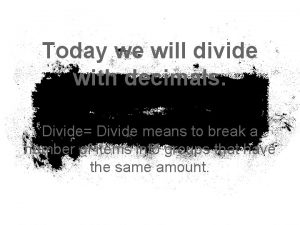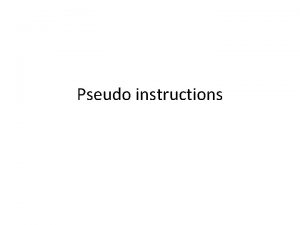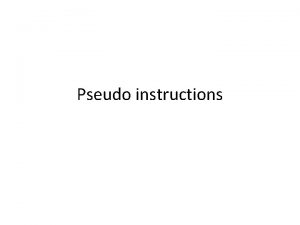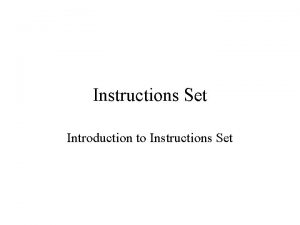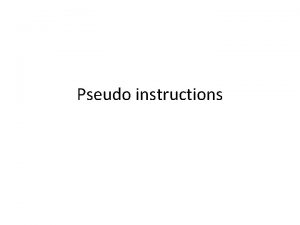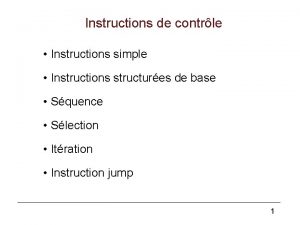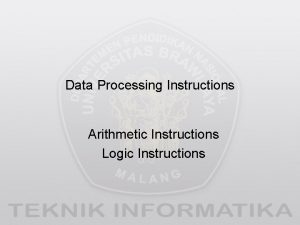Instructions for Playing Jeopardy 1 Divide the class























































- Slides: 55

Instructions for Playing Jeopardy 1. Divide the class into two or more teams. Write the name of each team on the board, leaving space beneath each one to write the points they earn. 2. To begin the game, bring up the game board (slide #4). Read and explain each of the categories. 3. The instructor chooses one of the squares for the first question. Click on the point value in the middle of the square. Read the question. The first person to raise his/her hand answers the question. 4. To see the answer, click one slide ahead. 5. If the answer is correct, that team receives the point value of the question. If the answer is incorrect, you may or may not choose to subtract the point value of the question from that team’s score. 6. If the student answered correctly, he or she then chooses the next question to answer. If the student answered incorrectly, the instructor chooses the next question. 7. To return to the game board (slide #4) and choose the next question, click on the image of the board at the bottom right of the answer slide: *Note: when a question has been answered, the point value for that question changes from yellow to black.

8. When all of the questions have been answered, it is time for “Final Jeopardy”. Add up the points earned by each team. This is the amount they have to wager with. Then go back to the game board (slide #4), click on the final jeopardy square, and read the category for the final question. Each team will secretly decide how much it wants to wager on this question. 9. Once all wagers have been made, click one slide ahead to see the question. Each team will secretly write down their answer. 10. When the time is up, click one slide ahead to see the answer to the question. Each team will then first reveal their answer and then say how much they wagered. If they got the answer right, they receive the amount of points they wagered. If they got it wrong, they lose these points. The team with the highest total number of points wins. Tip: Set a limit for the number of questions that an individual student can answer. This will avoid letting a small number of students answer all the questions and will help ensure that every student participates.


¿Tienen ánimo?

Estar with emotions and conditions Present Progressive Ser vs. Estar Direct Object Pronouns El Vocabulario $100 $100 $200 $200 $300 $300 $400 $400 Final Jeopardy $500

C 1 $100 Yo____un poco _______ porque tengo un examen mañana.

C 1 $100 Yo estoy un poco nervioso porque tengo un examen mañana.

C 1 $200 Mis hermanos______ muy_______ porque no durmieron (slept).

C 1 $200 Mis hermanos están muy cansados porque no durmieron (slept).

C 1 $300 Mrs. T always asks this to get our attention.

C 1 $300 ¿Están Listos clase?

C 1 $400 Esta clase no es muy interesante. ¿Estás_______ también?

C 1 $400 ¿Estás aburrido/a también?

C 1 final The final Jeopardy answer is: Translate into Spanish: Mrs. Thompson is pregnant. (you may use a dictionary) Timer

C 1 final Sra. Thompson está embarazada.

C 2 $100 He is fishing

C 2 $100 Está pescando

C 2 $200

C 2 $200 Está durmiendo

C 2 $300

C 2 $300 Está leyendo

C 2 $400 The present participle of preferir is:

C 2 $400 prefiriendo

C 2 $500 Present participle of conseguir is:

C 2 $500 consiguiendo

C 3 $100 Hoy ______el 3 de marzo.

C 3 $100 Hoy es el 3 de marzo.

C 3 $200 ¡Va a _____ un viaje fenomenal!

C 3 $200 ¡Va a ser un viaje fenomenal!

C 3 $300 Yo ____ muy feliz porque voy a ver a mi amiga.

C 3 $300 Yo estoy muy feliz porque voy a ver a mi amiga.

C 3 $400 Ella____ de Puerto Rico.

C 3 $400 Ella es de Puerto Rico.

C 3 $500 El partido de fútbol _____ en el estadio Centurylink.

C 3 $500 El partido de fútbol es en el estadio Centurylink.

C 4 $100 ¿Qué haces tú con el libro de viajes? (leer)

C 4 $100 Lo leo

C 4 $200 ¿Qué hacen los turistas en la ciudad? (explorar)

C 4 $200 La exploran

C 4 $300 ¿Qué hace el botones con el equipaje? (llevar)

C 4 $300 Lo lleva.

C 4 $400 ¿Qué hace la agente con las reservaciones? (confirmar)

C 4 $400 Las confirma

C 4 $500 ¿Qué hacen ustedes con los pasaportes? (Mostrar)

C 4 $500 Los mostramos

C 5 $100 open

C 5 $100 abierto

C 5 $200 marzo

C 5 $200 march

C 5 $300 Los meses del otoño incluye:

C 5 $300 Septiembre, octubre, noviembre

C 5 $400 En seattle ______ mucho en el invierno.

C 5 $400 llueve

C 5 $500 It’s snowing

C 5 $500 Está nevando
 Jeopardy instructions
Jeopardy instructions Formuö
Formuö Typiska novell drag
Typiska novell drag Tack för att ni lyssnade bild
Tack för att ni lyssnade bild Vad står k.r.å.k.a.n för
Vad står k.r.å.k.a.n för Varför kallas perioden 1918-1939 för mellankrigstiden
Varför kallas perioden 1918-1939 för mellankrigstiden En lathund för arbete med kontinuitetshantering
En lathund för arbete med kontinuitetshantering Personalliggare bygg undantag
Personalliggare bygg undantag Personlig tidbok för yrkesförare
Personlig tidbok för yrkesförare Sura för anatom
Sura för anatom Förklara densitet för barn
Förklara densitet för barn Datorkunskap för nybörjare
Datorkunskap för nybörjare Tack för att ni lyssnade bild
Tack för att ni lyssnade bild Mall debattartikel
Mall debattartikel För och nackdelar med firo
För och nackdelar med firo Nyckelkompetenser för livslångt lärande
Nyckelkompetenser för livslångt lärande Påbyggnader för flakfordon
Påbyggnader för flakfordon Tryck formel
Tryck formel Offentlig förvaltning
Offentlig förvaltning Kyssande vind
Kyssande vind Presentera för publik crossboss
Presentera för publik crossboss Jiddisch
Jiddisch Plats för toran ark
Plats för toran ark Treserva lathund
Treserva lathund Epiteltyper
Epiteltyper Bästa kameran för astrofoto
Bästa kameran för astrofoto Centrum för kunskap och säkerhet
Centrum för kunskap och säkerhet Programskede byggprocessen
Programskede byggprocessen Mat för idrottare
Mat för idrottare Verktyg för automatisering av utbetalningar
Verktyg för automatisering av utbetalningar Rutin för avvikelsehantering
Rutin för avvikelsehantering Smärtskolan kunskap för livet
Smärtskolan kunskap för livet Ministerstyre för och nackdelar
Ministerstyre för och nackdelar Tack för att ni har lyssnat
Tack för att ni har lyssnat Referatmarkering
Referatmarkering Redogör för vad psykologi är
Redogör för vad psykologi är Stål för stötfångarsystem
Stål för stötfångarsystem Tack för att ni har lyssnat
Tack för att ni har lyssnat Borra hål för knoppar
Borra hål för knoppar Vilken grundregel finns det för tronföljden i sverige?
Vilken grundregel finns det för tronföljden i sverige? Formula varians
Formula varians Tack för att ni har lyssnat
Tack för att ni har lyssnat Steg för steg rita
Steg för steg rita Ledningssystem för verksamhetsinformation
Ledningssystem för verksamhetsinformation Tobinskatten för och nackdelar
Tobinskatten för och nackdelar Blomman för dagen drog
Blomman för dagen drog Mästar lärling modellen
Mästar lärling modellen Egg för emanuel
Egg för emanuel Elektronik för barn
Elektronik för barn Plagg i rom
Plagg i rom Strategi för svensk viltförvaltning
Strategi för svensk viltförvaltning Kung dog 1611
Kung dog 1611 Indikation för kejsarsnitt på moderns önskan
Indikation för kejsarsnitt på moderns önskan Sju för caesar
Sju för caesar Tack för att ni lyssnade
Tack för att ni lyssnade Avrunda decimaltal
Avrunda decimaltal


























































